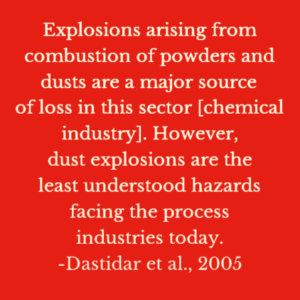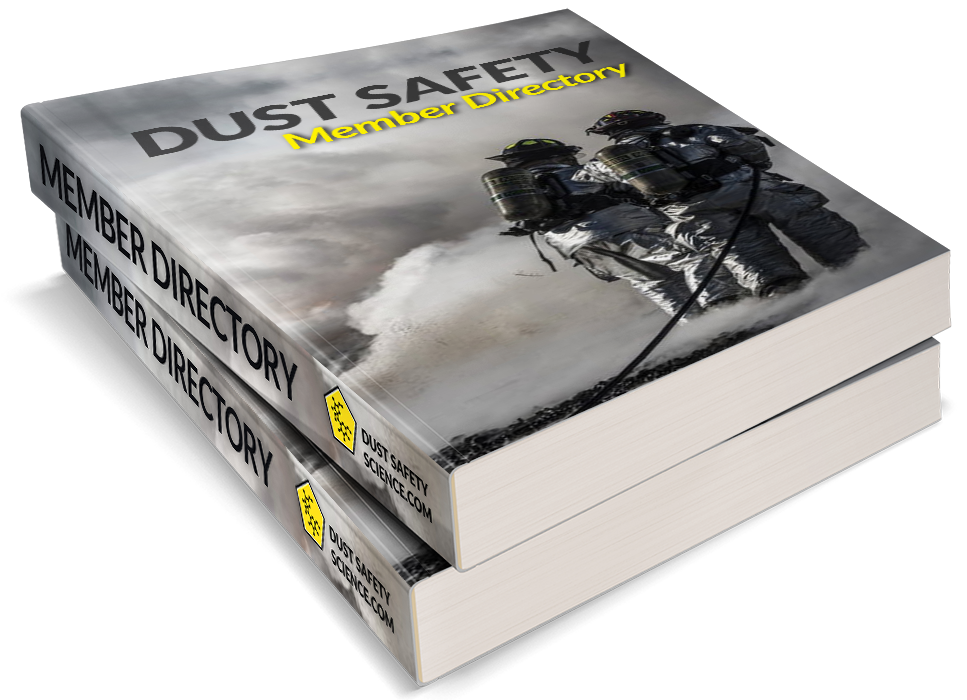1-Sentence-Summary: This paper gives a high-level overview of the standard approaches to dust explosion hazard analysis in processing facilities.
Authors: A. Dastidar, B. Nalda-Reyes, and J. Dahn
Read in: Three Minutes
Favourite quote from the paper:

The current authors give a high-level overview of the approaches, standards, and codes available to industry to characterize the hazard potential of dust and hybrid mixture explosions. A review of dust explosion probability and consequences tests is given along with a flow chart for hazard analysis.
Three of the main findings from this paper are:
- Dust explosion risk is characterized by probability and consequences which can be quantified using standardized testing.
- Dust characterization is only one part of a larger explosion hazard analysis.
- A successful hazard analysis requires substantial effort and commitment from management and plant personnel.
The following sections outline the main findings in more detail. The interested reader is encouraged to view the complete article at the link provided below.
Finding #1: Dust explosion risk includes both probability and consequence
Determining the risk of a dust explosion involves quantifying all five sides of the dust explosion pentagon: fuel, oxidizer, confinement, dispersion, and ignition. Explosion severity is typically characterized by maximum pressure, maximum rate of pressure rise, and deflagration index (volume normalized maximum rate of pressure rise). These are typically determined from explosion severity tests following ASTM E 1226. It is important to note that published literature data should not be used and that tests should be completed on dust from the actual facility.
Explosion probability can be quantified by several different parameters depending on the specific processes and mitigation measures being used. Of these the paper indicates Minimum Explosible Concentration (MEC) tested using ASTM E1515, Minimum Ignition Energy tested using ASTM E 2019, Limiting Oxygen Concentration (LOC), Auto ignition temperature of the dust cloud (MIT) tested using ASTM E 1491, and Autoignition Temperature of Dust Layers tested using ASTM E 2021.
Finding #2: Hazard analysis for dust and hybrid explosions involves at least 5 stages
The authors indicate that dust characterization (e.g., maximum pressure and maximum rate of pressure rise) is a required but not sufficient step in completing a full hazard analysis. The authors recommend a five step process to be completed:
- Collect Relevant Data
- Conduct Facility Walk Through
- Start Hazard Evaluation
- Risk Assessment
- Devise and Implement Hazard Mitigation Plan
The authors indicate several important considerations for each stage in the hazard assessment. The consequence and probability quantification are completed in the first stage where relevant data is collected. The authors recommend standard tools be used for hazard evaluation such as Fault Tree Analysis (FTA) and Hazard and Operable Studies (HAZOP).
Finding #3: Hazard analysis requires effort and buy-in
The final note from the authors is that creating a successful analysis where all hazards have been identified requires substantial effort and significant knowledge of the plant under study. They stress that this necessitates complete commitment from management and facility personal. They also give a useful list of various process equipment with potential ignition sources, upset frequency, and explosion consequence information.
My Personal Take-Aways From
“Evaluation of Dust and Hybrid Mixture Explosion Potential in Process Plants”
This paper gives a good high-level overview of the various aspects required for dust explosion hazard analysis. It would be useful for process safety consultants or anyone in the process industry that needs to evaluate the risk of dust or hybrid explosions in their facilities. The references to specific standards, methodologies, and typical statistics for process equipment may also be valuable to the reader.
Full Citation: [bibtex file=references.bib key=Dastidar2005]
[otw_shortcode_button href=”http://onlinelibrary.wiley.com/doi/10.1002/prs.10097/abstract” size=”medium” icon_position=”left” shape=”square”]> > Get The Article[/otw_shortcode_button]
